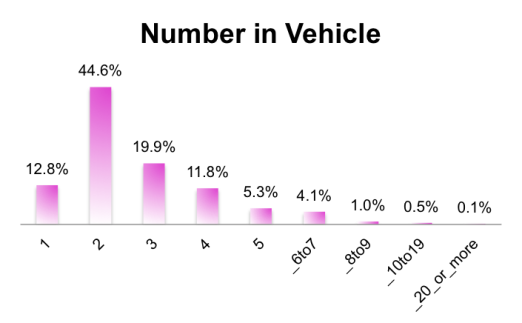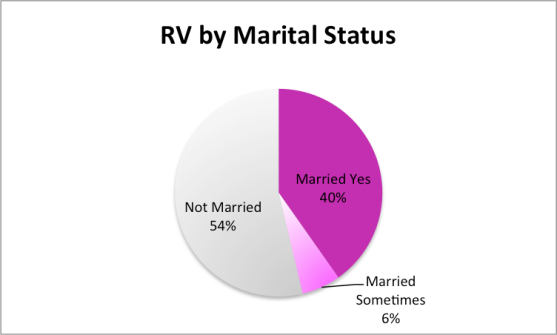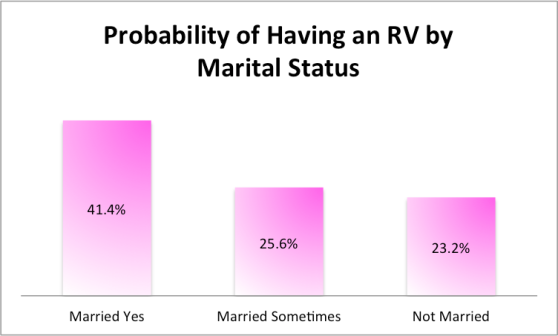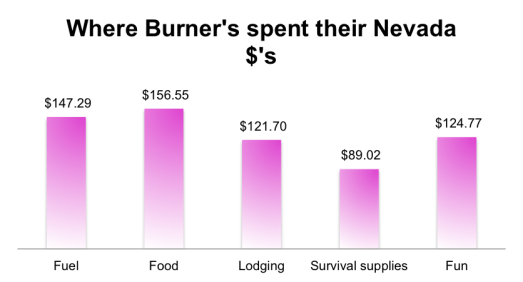Sometimes, it can seem like getting into Burning Man can take forever! At times there are even major delays – just this past year the gate was closed for an entire day due to rain. Although the large majority of Burners do make the long, slow drive along the playa to the entrance gate, that is not the only way into Black Rock City. In our survey of Burners, we learned that about 4% of the community does not enter through the front gate in private vehicles.

The Burner Express Bus accounts for nearly half of the entrances not through a private vehicle at the front gate. Additionally, 0.8% of you, or about 500 people, entered through the airport, while the remainder used other transportation methods or shuttles. So, although the front gate sees nearly everybody, about 2,500 people total have other transportation methods.
Of those who do travel by private vehicle, the breakdown of vehicle choice is fairly even among two distinct groups. First, about equal numbers of vehicle users travel by car, RV, SUV, or trucks with trailers, at 20% each. About 10% use a pickup. And bus, semi-trucks, motorcyclists, and walk-ins account for a small minority of vehicle users. Based on peak population numbers of 66,000, about 900 people arrived without a vehicle.
Looking at the number of people per vehicle, most cars arrived with two people, while about 40% arrived with three or more; this carpooling was perhaps driven by the limited availability of car passes.
Getting into the city itself is not the only part of the journey. For many people, driving from home to the event is doable, albeit long; however, many people cannot drive because to do so is unrealistic (if from the East Coast) or impossible (if international). As a result, the Reno airport sees a great deal of traffic from Burners flying into a convenient location prior to making their way to Black Rock City.
Most people who flew for some part of their journey arrived in Reno, at 9.7% of the BRC population. The next most common, and the largest nearby airport hub, was San Francisco International (SFO), with just slightly less at 9.1%. The remainder spread out among other California/Nevada airports. Finally, 0.9% flew into the BRC airport, matching those who stated they flew directly rather than drive (shown in the first figure, above).
Finally, now that we have an idea about how Burners get to BRC, what about the timeline? The population of Black Rock City was asked about their arrival and departure days. The figure below shows when people arrived at the event itself, and when they left at the end. There is a large spike on the first day for regular arrivals (Sunday), but notably, over 25% of the population of BRC arrived Monday or later, perhaps due to the large rainstorm that delayed many entries. On the other end of the spectrum, Sunday proved to be the most popular time to depart, after the burning of the Man. Even so, nearly 50% stayed until Monday or later, witnessing the Temple burn and to help clean up after the event.
Written by David DiTullio
Edited by Steven Michael Crane (Indiana)



















 Do we stop along the way and visit Nevada’s other attractions? The answer to that question is a definite “yes.” 25% of our participants visited a park or recreation area on their way to or from the event. Coming from Oregon, my group does take the time to look for new parks and areas to explore on our way to and from Black Rock City. Part of the experience is getting to and from Burning Man.
Do we stop along the way and visit Nevada’s other attractions? The answer to that question is a definite “yes.” 25% of our participants visited a park or recreation area on their way to or from the event. Coming from Oregon, my group does take the time to look for new parks and areas to explore on our way to and from Black Rock City. Part of the experience is getting to and from Burning Man. 




